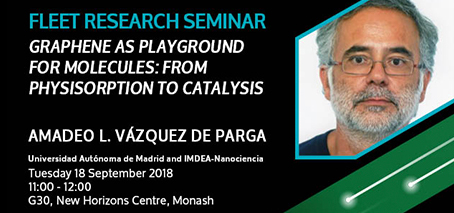-
18 Sep 2018
11:00 am - 12:00 pm
Graphene as playground for molecules: from physisorption to catalysis
Amadeo L. Vázquez de Parga
Universidad Autónoma de Madrid and IMDEA-Nanociencia, Madrid, Spain
All welcome! The seminar flyer can be downloaded here. Can’t be at Monash? You can also join via Zoom video conference via URL: https://monash.zoom.us/j/291267370
Abstract: Organic functionalisation of graphene has been suggested as an ideal tool to provide control over its electronic, optical, or magnetic properties. I will discuss three examples covering different aspects of graphene molecule interactions.
The first example I will discuss, is the physisorption of electron acceptor molecules, TCNQ, on graphene epitaxially grown on Ru(0001) and the formation of a full organic layer with long-range magnetic order. The molecules acquire a magnetic moment due to the charge transferred from the substrate as demonstrated by the Kondo resonance measured on individual TCNQ with Local Tunnelling Spectroscopy at low temperature. The molecular self-organization spontaneously leads to the formation of intermolecular, flat electronic bands, extending all over the molecular monolayer. The bands are spin split, with only the majority spin band being occupied. The existence of long-range magnetic order is detected by spin polarized STM at 4.6 K.
The second example described the covalent functionalization of graphene with strict spatial periodicity at the nanometer scale. We will prove the concept by the attachment of cyanomethyl radicals (CH2CN•) produced by homolytic breaking of acetonitrile (CH3CN), which is shown to present a nearly complete selectivity (>98%) binding covalently to graphene on specific atomic sites. The method have been extended to other organic nitriles, paving the way for the covalent attachment of functional molecules to graphene.
Finally, I will discuss how epitaxial graphene become a catalyser that promotes the reversible formation of a C-C bond between two organic molecules. The reaction is fully reversible as demonstrated by single molecule manipulation by injecting electrons with the STM tip on the empty molecular orbitals.
About the Speaker: Prof Amadeo L. Vázquez de Parga is currently visiting FLEET and MCATM for his sabbatical. He obtained his PhD at the Universidad Autónoma de Madrid (UAM). In 1993-1994 he carried out a post postdoctoral stay at I.B.M. Research laboratory in Rüschlikon (Switzerland) working on the characterization of the light emitted by the tunnel junction in a Scanning Tunnelling Microscope. From 1999 is Professor in Condensed Matter Physics at UAM, from 2008 is Associated Senior Researcher at IMDEA-Nanoscience and from 2013 Associated Research Professor at the Condensed Matter Physics Center (IFIMAC). During 2002 and 2003 was a visiting researcher at the Radbound University, Nijmegen (The Netherlands), working on spin-polarized Scanning Tunnelling Microscopy.
Venue: G30 New Horizons Centre, Monash University
Venue Website: https://www.monash.edu/engineering/our-research/facilities/new-horizons
Address:
